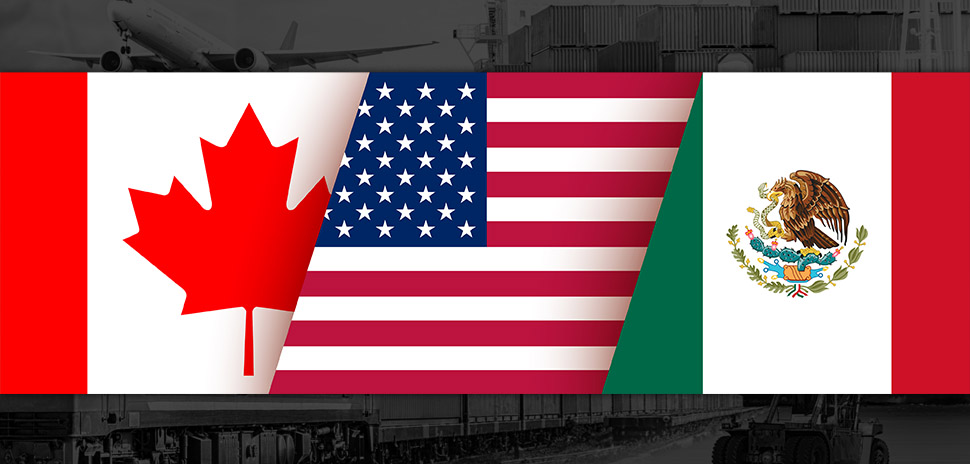On July 1, North American supply chains will begin operating under the new United States-Mexico-Canada Agreement (USMCA), formerly the North American Free Trade Agreement (NAFTA).
But, the launch of the renegotiated and modernized trade agreement is coming at a bad time for supply chains that have been disrupted during the COVID-19 pandemic, said Tiffany Melvin, President of the North American Strategy for Competitiveness (NASCO), in a DRC virtual International Task Force meeting on June 23.
“The timing of this could not be worse, having the pandemic on our hands,” Melvin said. “The supply chains have been disrupted, they’ve been strained, and there are labor shortages dues to illnesses. There are import and export restrictions on non-essential goods, borders are closed to non-essential travel, and every area of each country is in a different phase of the outbreak.”
While the USMCA is moving forward with some relaxed regulations, Melvin said there is a lot of uncertainty around whether businesses and their supply chains will be ready by July 1. The U.S. Customs and Border Protection launched a USMCA Center online to coordinate implementation.
Pre-pandemic research by the U.S. International Trade Commission showed that the USMCA would raise U.S. GDP by 0.35 percent, create 176,000 new jobs, and increase employment by 0.12 percent by 2026, the sixth year of implementation, Melvin said. But today, as the outbreak continues to rise in the U.S., it is unknown if the launch of USMCA will help or hurt the U.S. economic recovery from COVID-19.
The meeting included a panel discussion moderated by Sarah Carabias-Rush, DRC Senior Vice President of Economic Development and International Engagement, on the future of international trade and investment with a focus on supply chains. Melvin was joined by Allison Rosario, Partner at PwC, and Piotr Marczewski, Thomson Reuters President of Corporates of International Trade and Investment, with attention to supply chains.
One thing is certain, the USMCA and onset of COVID-19 have created a renewed interest in supply chains, Melvin said. While the agreement is largely the same as before, USMCA modernized and overhauled changes in the auto industry, environmental standards, and provides U.S. access to the Canadian dairy market.
North American trade among the three countries produces an annual trade value of $23 trillion, equating to $144 million per hour in trade transactions taking place for products that serve 490 million consumers, Melvin said.
“If you look at adoption of USMCA, it’s dynamic and a big event for the corporate decision-maker. But now it is very significantly disrupted by coronavirus,” said Piotr Marczewski, who focuses on trade data and supply chain analysis for corporations. “The supply chain is really the bloodstream of a company, especially if you’re in a manufacturing domain.”
In three decades, between 1987 and 2017, international trade grew by 600 percent and global supply chain truly became global, Marczewski said.
The virus has created an even more dynamic acceleration of change in supply chains as they adapted to new technologies in several days or weeks. The technology disruption shifted a company’s goal of trying to get goods in the fastest and cheapest way to a question of resiliency. Maintaining their chain of suppliers and customers to get direct to the consumer requires technology, he said.
“What used to be possible with just a pencil, and pen, and paper is now impossible to operate. You need to have technology deployed into the vast network of your supply chain to know in real time what the situation is, to be able to scenario plan,” Marczewski said. “Cost of goods account for 65 to 75 [percent] of a company’s revenues, meaning it touches 65 to 75 cents for every dollar of revenue, and that is why [supply chains] are phenomenally important.”
But even before the pandemic created a need for companies to pivot their supply chains to new technologies, more than half of 3,000 global CEOs surveyed by PwC in the fall of 2019 said they were adjusting their supply chain because they felt the number one threat to their business was global trade tension. About 160 of those CEOs operate inbound companies with significant operations in the U.S., and more than 50 percent said they were planning to act on their supply chain, optimization, and sourcing strategy.
“Supply chains are disjointed and can be broken regardless of your sector and your geography, and trade doesn’t make it any easier to figure out what the right optimization and strategy is,” said Allison Rosario, Assurance Partner at PwC. “We’ve seen a growing number of companies create a lot of agility in their sourcing strategy, like multiple sources for the same item, and that is in part due to economic reasons and various things that have happened.”
Post-COVID-19, the supply chain will need to assess its lessons learned, look at fit-for-purpose, and consider needs to pivot product strategy, Rosario said. While supply chain operations ranked number one for CEOs, Rosario said if the survey would be taken today, operational efficiency would be coupled with agility and output.
“Top of mind issues for CEOs are needing to feel very confident they have a strong environment to add products, making sure the products added are needed, and all those questions have supply chain implications,” Rosario said.
As companies grapple with supply chain disruptions and USMCA launches on July 1, the panelists agreed the Dallas Region fits well into the equation of globalization and has a strong playbook to continue to recruit business and investment.
“I’m very bullish on Dallas. I think we need to look at the ecosystem and Dallas playing in a broader context,” Marczewski said. “Dallas is very well and strategically positioned. It is and always has been. We need to stay positive.”
View the PwC report on international executives’ thoughts about investments in the U.S.
A version of this story first appeared on the Dallas Regional Chamber site. Dallas Innovates is a collaboration of D Magazine Partners and the Dallas Regional Chamber.
![]()
Get on the list.
Dallas Innovates, every day.
Sign up to keep your eye on what’s new and next in Dallas-Fort Worth, every day.
































